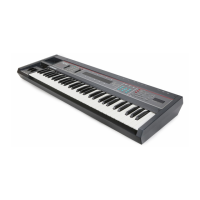SQ-80 — Musician's Manual
THE SEQUENCER
The Sequencer section of the SQ-80 is a integrated part of the design of the instrument, and an extremely
owerful device in its own right. Building a Sequencer this sophisticated into the same box with a
synthesizer creates many new possibilities for writing, recording and performing music. We think you
will find the Sequencer extremely straightforward and easy to use — having both your Sequencer and
your master keyboard controller right at your fingertips in one box is what makes the
ENSONIQ
approach to digital sequencing so unique.
At the same time, the great flexibility of this integrated synthesizer/sequencer design can make for a few
complexities, Since the Synthesizer and the Sequencer are interrelated, what you do on one sometimes
affects the other. There are a few possible routes to confusion here. However, if you pay close attention
to the explanations in this Manual, use your common sense, and open your mind to a few new concepts,
you will be happily sequencing in no time.
The eight-track
Sequencer built into the SQ-80 is based upon the same data structure as that of the
ENSONIQ ESQ-1. Since the two instruments share the same Sequencer file format, individual
sequences recorded on the
ESQ-1 can be transferred to and played on the SQ-80. and vice-versa (see p.
185 for more on
ESQ-1 compatibility).
Note: If you can't wait to start sequencing, you can turn right to the chapter "Recording a Sequence"
which begins on page 111. We recommend, however, that you eventually come back and familiarize
yourself with the many other Sequencer controls and functions described in this Section. This is the only
way to truly take advantage of the power of the
SQ-80 Sequencer.
The MIDI Connection
Almost everyone is familiar by now with MIDI — that magical connection that lets you play one
instrument (or a whole roomfull of them) from another. MIDI — Musical Instrument Digital Interface
is a standard that has been agreed upon by manufacturers for translating musical events into specific
numbers.
When you strike the Middle C on the
SQ-80, for instance, it instantly sends to its MIDI Out jack a series
of numbers representing a Key Down,
along with the location on the Keyboard, and how hard the key
was struck. When you release the key the
SQ-80 sends a number meaning Key Up. A MIDI instrument
connected to the
SQ-80 can read and translate those numbers to play the same middle C itself. The same
thing happens whenever you move a controller, such as the Pitch or MOD Wheel. or when you select
a new sound — each of these events is translated into a series of numbers which are transmitted out the
MIDI Out jack.
ow imagine a recorder which, instead of recording the sounds of an instrument, records the same kind
of Digital information that is sent and received over MIDI — Key Down, Key Up. Key Number and
Velocity. Pitch Bend, MOD Wheel, and so on — and you have imagined a Digital Sequencer.
A Sequencer records and plays back the "control information" rather than the actual notes. This means
that there is no degradation of the sound in the recording process no matter how many times you overdub
or re-record a part. A Sequencer is sort of an electronic player piano.
Section 4 — The Sequencer
81

